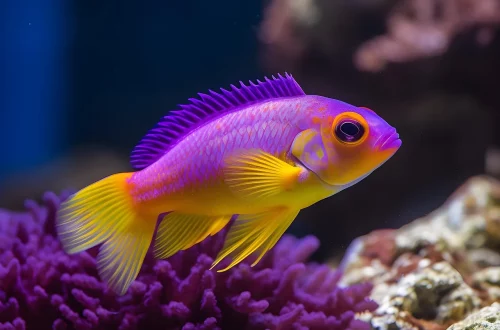
Creating a Stunning Small Marine Aquarium for Your Home
Creating a small marine aquarium at home can transform your living space into a vibrant underwater paradise. The gentle movement of fish, the swaying of aquatic plants, and the soft glow of lights create a serene atmosphere that can reduce stress and enhance your mood. Moreover, marine aquariums serve as fascinating conversation starters and can even provide an educational experience for children and adults alike.
However, embarking on this aquatic journey requires careful planning and consideration. Unlike freshwater tanks, marine environments are more complex and require a delicate balance of salinity, temperature, and pH levels. The beauty of a marine aquarium lies not just in its visual appeal but also in the intricate ecosystem that must be maintained. From selecting the right tank size to choosing compatible fish and corals, each decision plays a crucial role in the success of your aquarium. This endeavor is not merely about aesthetics; it is about creating a healthy habitat for marine life that thrives in your home.
Through thoughtful preparation and understanding of marine life, you can create a stunning small marine aquarium that not only beautifies your space but also fulfills the needs of its inhabitants.
Choosing the Right Tank Size and Location
The first step in creating a small marine aquarium is selecting the right tank size. While it may be tempting to opt for a smaller tank due to space constraints, it is essential to consider the implications of tank size on water quality and fish health. Smaller tanks can be more challenging to maintain, as fluctuations in water parameters can occur more rapidly. Generally, a tank size of at least 20 gallons is recommended for beginners, as it offers a more stable environment.
Once you have decided on the tank size, the next step is to choose an appropriate location. The placement of your aquarium is crucial for several reasons. First, you should ensure that the tank is positioned away from direct sunlight to prevent excessive algae growth and temperature fluctuations. Also, consider the proximity to electrical outlets and water sources for easy maintenance.
The aesthetics of your chosen location are equally important. A well-placed aquarium can become a focal point of your room, so think about how it complements your existing decor. Additionally, ensure that the surface the tank is placed on is sturdy and can support the weight of the filled aquarium, as water is surprisingly heavy.
After finalizing the tank’s location, it’s also beneficial to plan for any additional equipment you may need, such as filtration systems and heaters. This initial step will save you time and effort as you progress with your marine aquarium setup.
Essential Equipment for Your Marine Aquarium
To create a thriving marine environment, you’ll need to invest in essential equipment that supports the health and wellbeing of your aquatic inhabitants. The foundational elements of any marine aquarium include a reliable filtration system, a heater, and lighting.
A high-quality filtration system is critical for maintaining water clarity and quality. Marine aquariums require both mechanical and biological filtration to remove debris and harmful toxins. Consider a protein skimmer as part of your filtration setup, as it effectively removes organic waste before it breaks down and pollutes the water.
Heating is another vital component of your aquarium setup. Marine species often thrive in specific temperature ranges, so it is essential to keep the water heated appropriately. An adjustable aquarium heater will allow you to monitor and maintain the desired temperature, ensuring the comfort of your fish and corals.
Lighting is not just about aesthetics; it plays a crucial role in the health of your marine life. LED lighting is popular among aquarists because it is energy-efficient and can be tailored to provide the spectrum needed for coral growth. Depending on the type of corals you intend to keep, you may need specialized lighting that mimics natural sunlight.
Additionally, you’ll want to consider other equipment such as water testing kits, which help you monitor pH, salinity, ammonia, and nitrate levels. Regular testing is essential to ensure a healthy environment for your marine inhabitants.
Selecting Marine Species for Your Aquarium
Choosing the right marine species for your aquarium can be one of the most enjoyable aspects of setting up your tank. However, it is important to research and understand the compatibility and needs of different species before making your selection.
Start by considering the types of fish you want to keep. Some popular beginner-friendly fish include clownfish, damselfish, and gobies. These species are generally hardy and can adapt well to new environments. When selecting fish, it’s crucial to consider their size, temperament, and dietary needs to ensure they can coexist peacefully in your aquarium.
In addition to fish, many aquarium enthusiasts enjoy adding corals to their setups. Corals not only enhance the beauty of your aquarium but also contribute to the overall health of the ecosystem. Soft corals, such as zoanthids and mushrooms, are often recommended for beginners, as they are relatively easy to care for.
When planning your marine aquarium, be mindful of the bioload—the total mass of living organisms in the tank. Overcrowding can lead to poor water quality and stress for the fish, so be sure to adhere to the one inch of fish per gallon rule as a general guideline.
Lastly, consider the long-term commitment of keeping a marine aquarium. Some species may live for several years, requiring ongoing care and maintenance. Thus, it is vital to choose species that you can commit to caring for, ensuring a sustainable and healthy environment for all inhabitants.
Maintaining Water Quality and Care
Maintaining water quality is one of the most critical aspects of marine aquarium care. Regular monitoring and maintenance will help you prevent problems before they arise, ensuring a thriving environment for your fish and corals.
Start by establishing a routine for testing water parameters, including salinity, pH, ammonia, nitrite, and nitrate levels. Salinity can be measured using a hydrometer or refractometer, while pH testing kits are widely available. Regular water changes, typically 10-20% every couple of weeks, are essential in keeping nitrate levels in check and replenishing essential minerals.
In addition to water changes, you should also clean the aquarium regularly. This includes cleaning the substrate, removing algae buildup, and maintaining your filtration system. Be sure to replace filter media as needed, as this will promote efficient filtration and help maintain water clarity.
Feeding your marine inhabitants the right diet is also a crucial component of aquarium care. Ensure that you provide a varied diet that meets the nutritional needs of your fish and corals. Overfeeding can lead to excess waste and poor water quality, so be sure to adhere to recommended feeding guidelines.
Finally, be patient during the cycling process of your aquarium. This initial period can take several weeks, as beneficial bacteria establish themselves in the tank. Rushing this process can lead to imbalanced water conditions, which can harm your marine life.
Creating a stunning small marine aquarium is an exciting and fulfilling journey that requires attention to detail and a commitment to care. By choosing the right equipment, selecting compatible species, and maintaining water quality, you can enjoy the beauty and serenity of an underwater paradise in your home.
While this article provides general guidance on marine aquariums, it is important to note that individual circumstances may vary. For specific health-related concerns regarding marine life or your aquarium setup, please consult a professional aquarist or veterinarian.




